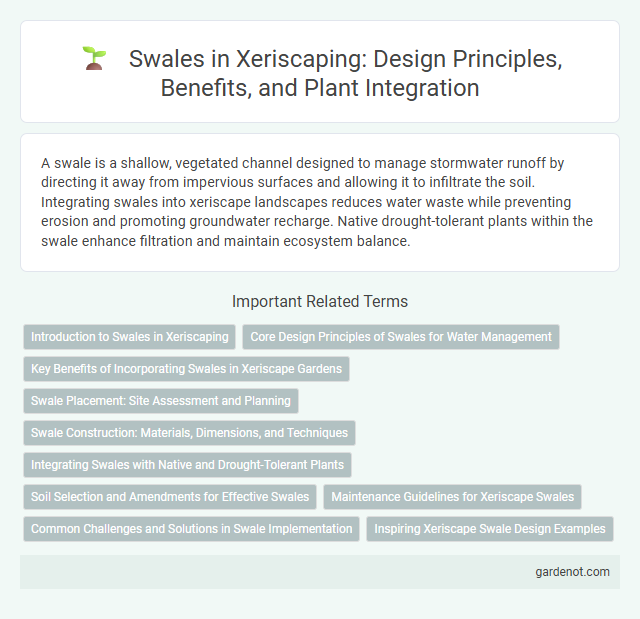A swale is a shallow, vegetated channel designed to manage stormwater runoff by directing it away from impervious surfaces and allowing it to infiltrate the soil. Integrating swales into xeriscape landscapes reduces water waste while preventing erosion and promoting groundwater recharge. Native drought-tolerant plants within the swale enhance filtration and maintain ecosystem balance.
Introduction to Swales in Xeriscaping
Swales in xeriscaping are shallow, vegetated channels designed to capture and slow stormwater runoff, allowing it to infiltrate the soil and reduce erosion. They enhance water conservation by directing rainwater to landscaping plants, minimizing irrigation needs and supporting drought-tolerant vegetation. Incorporating swales optimizes rainwater management and promotes sustainable xeriscape garden ecosystems.
Core Design Principles of Swales for Water Management
Swales are shallow, vegetated channels designed to capture, convey, and infiltrate stormwater, reducing runoff and preventing erosion in xeriscape landscaping. Key design principles include proper sizing based on watershed area, gentle side slopes for stability, and use of deep-rooted native plants to enhance water absorption and soil retention. Effective swales balance hydraulic efficiency with ecological function, promoting groundwater recharge while maintaining landscape aesthetics.
Key Benefits of Incorporating Swales in Xeriscape Gardens
Swales in xeriscape gardens significantly enhance water conservation by directing and capturing runoff, promoting efficient irrigation without relying on supplemental watering. They reduce soil erosion and improve groundwater recharge, supporting sustainable landscape health in arid environments. Integrating swales also fosters native plant growth by maintaining optimal moisture levels, reducing maintenance and water costs.
Swale Placement: Site Assessment and Planning
Swale placement requires thorough site assessment, analyzing soil type, slope, drainage patterns, and existing vegetation to ensure effective water capture and infiltration. Proper planning incorporates the natural flow of runoff from landscapes, optimizing swales to reduce erosion and promote groundwater recharge in xeriscaping projects. Strategic positioning enhances water conservation by directing runoff to drought-tolerant plantings, improving site sustainability and landscape health.
Swale Construction: Materials, Dimensions, and Techniques
Swale construction involves creating shallow, vegetated channels designed to manage stormwater runoff efficiently while promoting infiltration. Common materials include native soil, mulch, and dense vegetation such as grasses and shrubs, with typical dimensions ranging from 1 to 3 feet in width and 6 to 12 inches in depth to accommodate local rainfall patterns. Techniques emphasize contour alignment perpendicular to slope, proper soil compaction to prevent erosion, and layering with permeable substrates to enhance water retention and filtration within xeriscape landscaping.
Integrating Swales with Native and Drought-Tolerant Plants
Swales effectively manage stormwater runoff while supporting xeriscape principles by incorporating native and drought-tolerant plants that enhance soil infiltration and reduce erosion. Integrating species like purple coneflower, buffalo grass, and yarrow maximizes water efficiency and provides habitat for pollinators. This combination promotes sustainable landscaping by reducing irrigation needs and improving ecosystem resilience in arid environments.
Soil Selection and Amendments for Effective Swales
Soil selection for effective swales requires well-draining, loamy soil rich in organic matter to facilitate water infiltration while preventing erosion. Incorporating amendments such as compost or aged mulch enhances soil structure, moisture retention, and nutrient availability critical for xeriscape swale plants. Ensuring a balanced soil pH and adequate microbial activity supports long-term soil health and optimal swale function in arid landscapes.
Maintenance Guidelines for Xeriscape Swales
Xeriscape swales require regular inspection to ensure proper water flow and prevent erosion, with debris removed to maintain permeability. Native drought-tolerant plants within the swale need seasonal pruning to encourage healthy growth and reduce fire risk. Mulching with organic material assists in moisture retention and weed suppression, minimizing maintenance efforts.
Common Challenges and Solutions in Swale Implementation
Swale implementation often faces challenges such as soil erosion, poor drainage, and inadequate vegetation establishment, which can compromise water retention and filtration efficiency. Solutions include using erosion control blankets, selecting deep-rooted, drought-tolerant plants native to xeriscape environments, and incorporating permeable soil amendments to enhance infiltration. Proper grading and regular maintenance also help prevent waterlogging and sediment buildup, ensuring optimal swale performance in sustainable landscape designs.
Inspiring Xeriscape Swale Design Examples
Swale designs in xeriscaping serve as innovative solutions for efficient water management and erosion control, showcasing a blend of functionality and aesthetics. Examples range from gently contoured, vegetation-lined swales that capture and filter rainwater to terraced swale systems that maximize infiltration on sloped landscapes. These inspiring xeriscape swale designs not only conserve water but also promote native plant growth, improve soil health, and create visually appealing sustainable landscapes.
Swale Infographic

 gardenot.com
gardenot.com